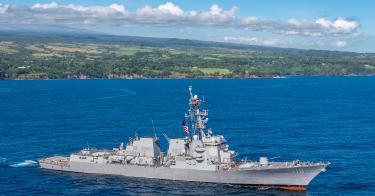The Navy‘s rush to shutter its primary fuel storage site in the Pacific without a ready replacement poses serious national-security issues, especially with growing tensions in the region with China, Russia and North Korea.
After years of mismanagement, fuel leaks at the Red Hill storage facility in Honolulu had gotten so out of hand that they threatened Hawaii’s water supply.
The secretary of defense had little choice but to shutter it in March. Yet, this facility is critical to sustaining the Navy‘s fleet in the Pacific. It cannot simply be drained and padlocked.
At a January 2022 House Armed Services Committee hearing, the Pacific Fleet’s deputy commander made clear the importance of the site and of the significant potential for operational impacts after February if it were closed. We have heard nothing from the Navy on this since.
However, a 2018 Environmental Protection Agency review for alternative sites makes clear that Red Hill’s 250 million gallon fuel-storage capacity is essential to the conduct of wartime and peacetime Pacific theater operations.
Now, six months after Defense Secretary Lloyd Austin’s memo directing Red Hill’s closure, it appears defueling has progressed quicker than anticipated. Absent in his memo was a timeline for validating a replacement for Red Hill. The secretary of the Navy hinted the replacement strategy would include using tankers at sea to store fuel for the military, but few details have been made public.
It appears that the Navy has successfully plugged the fuel leaks at Red Hill, yet the facility remains closed. Some in Congress are skeptical that, without it, the Pacific fleet may be unable to get the fuel it needs.
Rep. Rob Wittman, Virginia Republican, voiced his concerns in March, saying, “Let me tell you, we’d better be doggone confident that we have fuel in other places around the Pacific Rim to make sure we have it.”
Six months later, little has been announced or demonstrated to indicate how Red Hill will be replaced.
The best insight as to a potential Red Hill alternative came in a two-page fact sheet the Defense Department released in March. While the information is very limited, it indicates commercial sites and tankers will play a role. Moreover, the recently released updated defueling plan is mum on validating a replacement that meets the military’s needs.
>>> The Navy’s Navigation Plan Is Good, but Congress Has Some Heavy Lifting To Do To Make It Work
That said, a defueling plan supplement is planned for release by the end of September. Hopefully, it will provide assurances that a demonstrated replacement is on hand. Sadly, given the apparent urgency to shut down the facility, it is more likely the military, notably the Navy, will have to make do for some time with suboptimum fueling.
To be clear, the Navy has by all accounts been negligent in its stewardship of Red Hill. But its newfound concern with Hawaii’s water supply and an administration myopically focused on climate change is clouding sound military judgment on this issue.
This could prove dangerous given rising tensions. China, Russia and North Korea have all been rattling their sabers lately in the Pacific.
Prudence dictates the secretary of defense ensure the military has on hand the means to sustain combat operations in the Pacific without interruption. That assurance is in the public interest just as much as assuring that families in Hawaii, mine included, have safe drinking water. It is not an either-or proposition.
This piece originally appeared in The Washington Times




